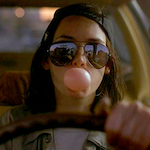 “Like Popeye says, ‘I yam what I yam,’ right?”
“Like Popeye says, ‘I yam what I yam,’ right?”
On May 1, 1992, Fine Line Features released Jim Jarmusch’s NIGHT ON EARTH on a mere 40 screens. By comparison, LEAVING NORMAL was released to 362 screens on the same day, and nobody ever heard of that one. But this was a well marketed limited release – I knew NIGHT ON EARTH existed, and in fact went to see it on one of those 40 screens, specifically the one that was upstairs at Seattle’s Harvard Exit Theatre (1968-2015).
 This is Jarmusch’s fifth film. It’s possible I’d seen STRANGER THAN PARADISE and DOWN BY LAW already, but I suspect I rented them after seeing this. (I know I’d never heard of PERMANENT VACATION and saw MYSTERY TRAIN later.) So I may not have realized that by his standards it was kind of commercial: in Winona Ryder (who had BEETLEJUICE, HEATHERS and EDWARD SCISSORHANDS under her belt and was about to do BRAM STOKER’S DRACULA) he had his biggest movie star to date, and despite its simplicity it sure seems to have a bigger budget than his previous films, since it’s filmed on location in four different countries.
This is Jarmusch’s fifth film. It’s possible I’d seen STRANGER THAN PARADISE and DOWN BY LAW already, but I suspect I rented them after seeing this. (I know I’d never heard of PERMANENT VACATION and saw MYSTERY TRAIN later.) So I may not have realized that by his standards it was kind of commercial: in Winona Ryder (who had BEETLEJUICE, HEATHERS and EDWARD SCISSORHANDS under her belt and was about to do BRAM STOKER’S DRACULA) he had his biggest movie star to date, and despite its simplicity it sure seems to have a bigger budget than his previous films, since it’s filmed on location in four different countries.
It’s an anthology film made up of five vignettes filmed in different cities – Los Angeles, New York, Paris, Rome, and Helsinki – each about a taxi driver and one of their fares for the night. It’s very grounded in the sense that it’s entirely about regular people’s conversations. But the opening shot zooming into (artificial looking) Earth, set to what I can only describe as the wobbly sailor-poet-carnival-spy-blues-accordion-ballad score by Tom Waits, implies to me the perspective of a friendly alien admiring the peculiarities and sad beauty of human life.
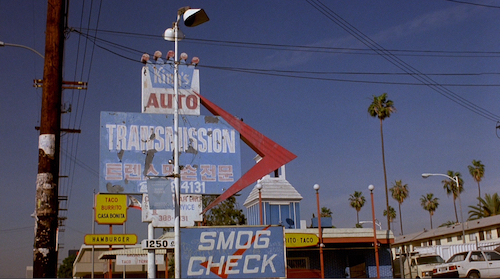
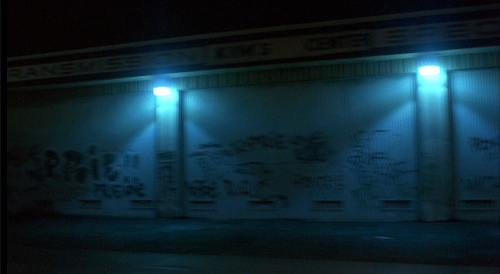
The Los Angeles story stars Ryder (“I myself am strange and unusual” —Lydia Deetz) as a young cabbie named Corky. She wears a backwards baseball hat, chews gum while chain-smoking, and when her passenger, Victoria Snelling (Gena Rowlands, MACHINE GUN MCCAIN), needs the number for the hotel, we learn that she’s so small she’s been sitting on a phone book.
“Are you okay without it up there?” Victoria asks when Corky passes it back to her.
Victoria is a Hollywood casting agent who just got back from a trip, and is struggling to find a candidate for a part that will satisfy the director. She makes some phone calls, which is such a normal cab (or Lyft) activity now that I forgot until after this viewing that at the time having a mobile phone was a symbol of her being a big shot.
Ryder is a little older than me, so it was funny to watch it all these years later and realize that she’s basically a kid driving a cab. I don’t remember thinking of it that way, even though it’s commented on. She’s fun to watch, though her talk about life as a tomboy car nut is not among her more convincing work. I think that’s because she made her name playing kids who radiate intelligence beyond their years, while here she’s trying to play up how young she is.
There’s a sort of punchline that makes the whole segment. As she’s being dropped off at her place, Victoria finally has the realization we’ve been waiting for the whole time – that Corky might be the fresh new natural face she’s looking to cast. Corky turns her down, not because she thinks she wouldn’t be good at it, but because she simply has no interest. Being a movie star might be fun, but she already has a job and doesn’t want to risk her plans to become a mechanic. Victoria smiles at her with both complete befuddlement and profound admiration.
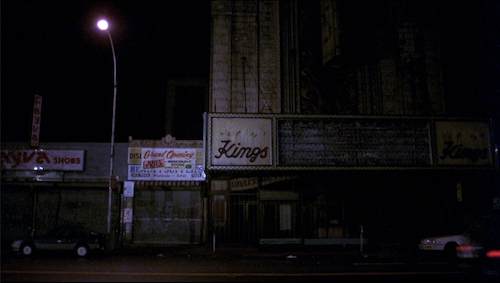
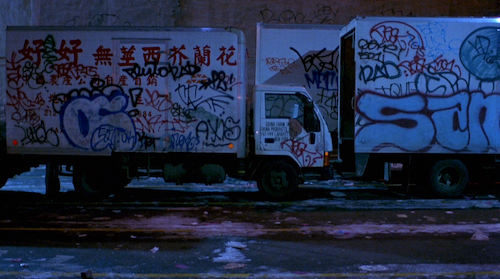
The New York story is easily my favorite. The passenger is played by Giancarlo Esposito, who was between HARLEY DAVIDSON AND THE MARLBORO MAN and BOB ROBERTS. He’s had such a career playing cold, calculating menaces that it’s kind of thrilling to see another role with the unrestrained energy of when he played Buggin Out in DO THE RIGHT THING. It’s a cold night and the traffic seems to be almost entirely made of taxis, but he can’t get any of them to stop to bring him home to Brooklyn.
So he has to settle for Helmut (Armin Mueller-Stahl, who had just been in Barry Levinson’s AVALON, would soon be in Steven Soderbergh’s KAFKA, and would eventually be in Jonathan R. Betuel’s THEODORE REX), an East German immigrant on his first day as a cab driver. Not only does he have to be given directions where to go, but how to put the car in drive. He’s so horrible that Esposito’s character makes him pull over and, after some arguing, convinces him to let him drive.
So these two drastically different characters sit in the front seat together, discuss their very different backgrounds (Helmut is a former clown). Esposito laughs at the name “Helmut” sounding like “helmet” before revealing that his name is YoYo. Which does not seem funny to him.
A highlight is when Helmut points out that they’re wearing similar ear flap snow hats, and YoYo can’t see it.
“Mine’s the newest latest, mine is fresh.”
“No, the ear things here. The same. Ear.”
I love this joke. It’s very Jarmusch. One of my favorite things in GHOST DOG is how he explores the overlaps between very different cultures, and this is related, I think. Helmut sees it as common ground that they’re wearing the same type of hat, but YoYo can’t (or doesn’t want to) see beyond the context of his being a cool thing he acquired for fashion purposes. He doesn’t want to see it as standard snow protection for old men in Europe.
On the way to Brooklyn YoYo spots his sister-in-law Angela (Esposito’s DO THE RIGHT THING cast-mate Rosie Perez), who he thinks shouldn’t be out at night, and physically drags into the car to bring home. Perez of course utilizes her super power of chewing him out from the back seat – I kept thinking what an honor it must be to be told to be told to shut the fuck up by Rosie Perez in a movie – while Helmut watches, amused, then timidly comments on how beautiful she is. I love how long they’re in the car before Angela is watching them interact and we see on her face as she starts to wonder why YoYo is driving a cab and who this other guy is.
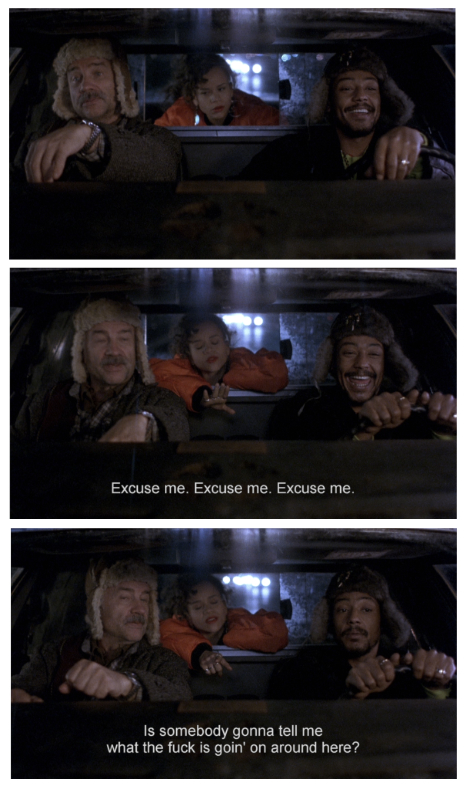
It’s such a great short story because it feels like an A+ buddy movie team-up, but it’s just for this one transaction. Just a weird thing that happened to them for part of one night. There’s pretty much no chance these people will ever see each other again, or think about each other many times. But this is the only part of their lives we’ll ever see, so the profundity of the encounter is magnified.
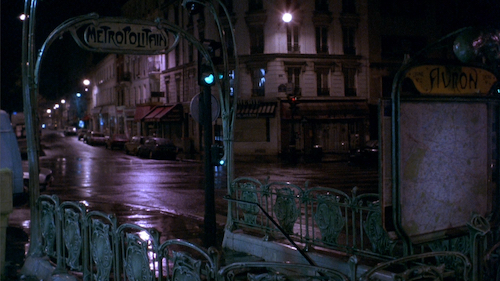
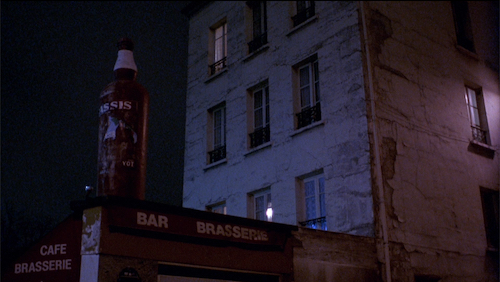
The Paris story stars Isaach de Bankolé as an unnamed driver, first driving two African immigrants played by Pascal N’Zonzi (THE PROFESSIONAL) and Emile Abossolo M’bo (IN THE EYE OF THE SNAKE). They call themselves “extremely important people” and laugh about some ambassador they were having champagne with, and he seems very annoyed with them. They start trying to guess which country he’s from and when he says he’s from the Ivory Coast, they start teasing him with stereotypes, so he makes them get out in the middle of nowhere.
I doubt they’re the worst people he’s had in his cab, but I hate when people disrespect service workers, so I enjoy him standing up for himself.
“Can’t we have some fun?”
“I work in this taxi. It’s my place of business, not your fucking playground!”
The focus of the story is his next passenger, a blind woman played by Béatrice Dalle (then known as the star of BETTY BLUE, later “La femme” in INSIDE) When he sees her he says, “Here’s one that won’t give me any shit,” and then the first thing she says to him is “Nice driving, asshole. You almost flattened me.”
Their interaction is all about him being curious about her, asking pretty inappropriate questions, and her revealing an interesting personality through her disgusted responses. Dalle is not blind, so this might be considered offensive today, but it’s a hell of a performance. Due to the character’s Don’t Give a Fuck attitude she does not hide her eyes with glasses, and perhaps Dulle is wearing contacts, but it really looks like she’s rolling her eyes up into her head. If so, I don’t know how the fuck she can act while doing that!
Of course she’s annoyed that he’s making a big deal about her blindness, which she doesn’t see as a disability, but he keeps poking at why it must be hard. “You can’t drive a car, for example.”
“And you can?” she says. He seems to know she won that round, but he doesn’t shut up. She has to tell him “I don’t give a fuck about colors.” And unlike those guys who could see his face, she guesses what country he’s from.
Her final victory over his condescension is when they reach her destination and he asks for less money than the meter says. She not only detects the lie but is insulted by the charity, says “Do I look like I was born yesterday?” and correctly estimates what she really owes him.
De Bankolé really is from the Ivory Coast, but his parents are from Benin, so those guys weren’t entirely wrong. This was his first American production, after being in a number of French films and one French-Canadian one. About five years after this he moved to the United States, and though he’s been in CASINO ROYALE, MIAMI VICE, THE LAST WITCH HUNTER and BLACK PANTHER and was the lead in Jarmusch’s THE LIMITS OF CONTROL, I will always think of him as the ice cream man in GHOST DOG.
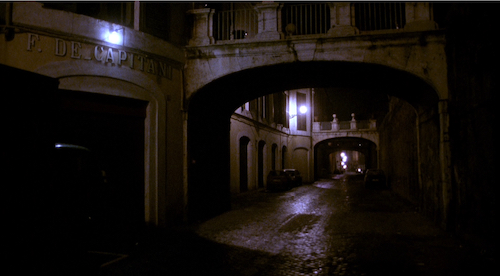
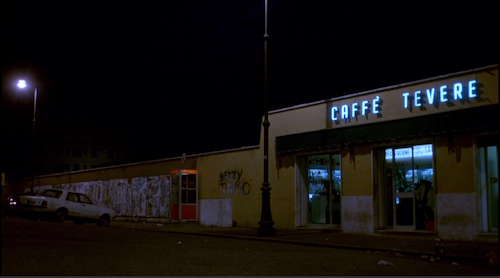
The Rome story is the most broadly comedic one. Roberto Benigni plays the driver, he picks up a priest (Paolo Bonacelli, , CHRIST STOPPED AT EBOLI, CALIGULA) who sits horrified in the back seat, seeming to struggle with chest pains as he chokes on the driver’s cigarette smoke, braces for his reckless driving and is forced to take confession. He repeatedly says no but the driver tells him all about his childhood sex experimentation with pumpkins and a sheep.
Some of this is indeed funny, my favorite being when the priest says, “My son, may I ask you a favor? Take off your sunglasses. It’s not safe to drive at night with dark glasses.” The driver reaches for the glasses, seems genuinely surprised and claims to have forgotten he was wearing them.
When I saw this I either had never seen Benigni before, or only knew him from DOWN BY LAW. It was surprising for this type of goofball to show up at this point in the movie, and that made it funny. Benigni’s rise to global fame started right after this – his next four films were JOHNNY STECCHINO, SON OF THE PINK PANTHER, THE MONSTER and LIFE IS BEAUTIFUL. Being a little more familiar with him now, the morning-radio-DJ/improv-guy-who’s-always-on/Uncle-Joey-from-Full-House feel of the humor is more apparent. He’s doing voices and sound effects, riffing on the name of a hotel, saying “that wall wasn’t here yesterday” when he almost crashes… this is all when he’s alone, so you can imagine how exasperating he gets when he has someone in the car to perform for. I prefer the dryer humor of the other segments. But I guess it’s good to have some variety.

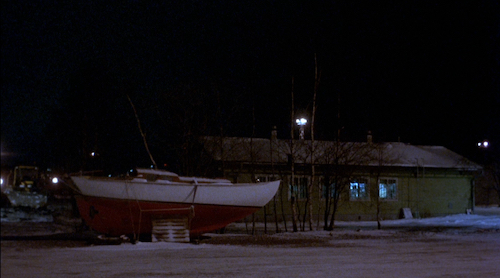
The final chapter in snowy Helsinki is much more melancholy. Everyone in the cast had been in one or more films directed by Aki Kaurismäki, who is thanked in the credits and is an acknowledged influence on Jarmusch’s work. Mika (Matti Pellonpää) is the stern-faced, long-mustached driver who picks up three very drunk friends played by Kari Väänänen, Sakari Kuosmanen and Tomi Salmela. The one named Aki is unconscious, drunker than his friends because “today was the worst fuckin day of his life,” they claim. They promise to pay the fare with his severance pay.
This section is basically one long joke, one of those ones like “The Aristocrats” or a Norm MacDonald one where it’s a simple structure and it’s all in the elaboration of the teller. The joke is that the passengers belligerently tell the driver about their friend’s awful day, to prove that he could never understand the pain he’s in. Then he tells them a story so sad they’re in tears, giving him hugs and saying, “Aki is so full of shit. His life isn’t so terrible after all. He fuckin whines about such trivial shit. Some people have got real troubles.”
If I told you what the driver’s story is about it would sound like much too grim of a note to end the movie on, but in the context of how it’s told, and as a facet of the larger anthology, I find it heartwarming. He’s gone through something horrible, and these strangers’ attempts at hopeful encouragement are unconvincing. Yet the very idea of this man who must ordinarily keep his emotions inside finding sympathy and sincere (if pathetic) gestures of support from these drunk strangers is beautiful, I think.
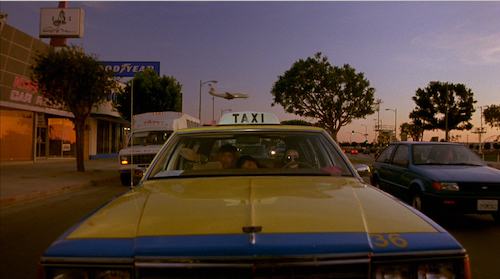 This was Jarmusch’s first time working with director of photography Frederick Elmes (ERASERHEAD, VALLEY GIRL, MOONWALKER), but they would later do BROKEN FLOWERS, PATERSON and THE DEAD DON’T DIE (and one segment of COFFEE & CIGARETTES – I’m not sure when that was shot). Editor Jay Rabinowitz had cut Jarmusch’s video for the Tom Waits Red Hot + Cool contribution “It’s All Right With Me” in 1990, and this was his first feature. In addition to many Jarmusch films he went on to edit Paul Schrader’s AFFLICTION, Darren Aranofsky’s REQUIEM FOR A DREAM, Curtis Hanson’s 8 MILE, and (holy shit!) Terence Malick’s THE TREE OF LIFE.
This was Jarmusch’s first time working with director of photography Frederick Elmes (ERASERHEAD, VALLEY GIRL, MOONWALKER), but they would later do BROKEN FLOWERS, PATERSON and THE DEAD DON’T DIE (and one segment of COFFEE & CIGARETTES – I’m not sure when that was shot). Editor Jay Rabinowitz had cut Jarmusch’s video for the Tom Waits Red Hot + Cool contribution “It’s All Right With Me” in 1990, and this was his first feature. In addition to many Jarmusch films he went on to edit Paul Schrader’s AFFLICTION, Darren Aranofsky’s REQUIEM FOR A DREAM, Curtis Hanson’s 8 MILE, and (holy shit!) Terence Malick’s THE TREE OF LIFE.
Between segments we see a wall of clocks for each city, each time reversing to show that the stories take place simultaneously. But since we’re moving across the globe they happen progressively later into the night, giving us the feeling of hanging out in these cabs through a whole night. We get to start before the sun goes down and end as it’s coming up.
Sadly, L.A. is the only one of these cities I’ve actually been to. But that segment (partly because it’s about a long drive from the airport) really captures the way it feels to me. Watching this movie gives me a sense memory of traveling. Jarmusch makes us visually compare and contrast the five cities. He has such an eye for locations that represent the personality of the city without standing out too much – each region’s variation on weathered structures and old signage. Usually there are clocks. Often there is graffiti, but not the fancy kind.
Helmut says the Brooklyn Bridge is “beautiful” and the neighborhood is “great,” YoYo seems proud of it only because it’s home, while Angela calls it “a dump.” In all of these movies we see worn down buildings that we can understand as both ugly and beautiful. Helsinki looks like the least ravaged of these cities, but to my eyes the most depressing. In some sense this is a tribute to the character of urban areas, even when they’ve seen better days.
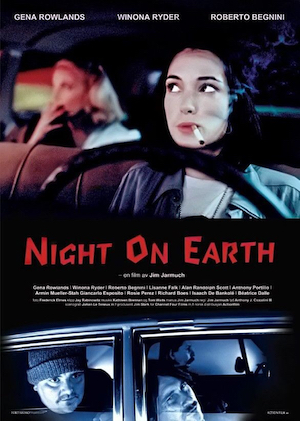 But cities are just the surroundings. Most of the movie takes place inside cars. Like THE PLAYER, this is a 1992 movie that has since been enshrined in the Criterion Collection, which is why I was able to see a Belgian TV interview where Jarmusch explains his concept of the movie.
But cities are just the surroundings. Most of the movie takes place inside cars. Like THE PLAYER, this is a 1992 movie that has since been enshrined in the Criterion Collection, which is why I was able to see a Belgian TV interview where Jarmusch explains his concept of the movie.
“What I really liked was the idea that in a taxi you are in a space with someone alone and you have nothing invested in your relationship. You can say whatever you want, you can be completely honest or dishonest, and that kind of freedom of an intimate relationship with a stranger for a brief time was interesting to me.” (Oh shit – did he accidentally invent Taxicab Confessions?)
He also says that where you’re coming from and going to are usually the significant parts of a taxi ride, “So I liked the idea to make a film made up of the insignificant moments.”
Sometimes I wonder about filmmakers directing actors in a language besides their own. I laugh when Asian movies have white guys doing lines in English and it seems like the director might not have known how bad they were. Jarmusch says he speaks French, understands some Italian, and no Finnish. But he doesn’t know Japanese either and was able to direct MYSTERY TRAIN. This dynamic also extends into GHOST DOG, where Forest Whitaker’s Ghost Dog and de Bankolé’s ice cream man have conversations without knowing each other’s language but come to the same conclusions as each other.
One thing that never occurred to me before is how well NIGHT ON EARTH is structured to lure in young people taking their first steps outside of mainstream Hollywood type fare. It opens with its biggest American movie star, the first two stories are in the U.S and in English., then it proceeds to the subtitled sections, and ends on the bleakest one. I don’t think I needed that type of coaxing back then, but it couldn’t have hurt. Not that I think it was planned that way.
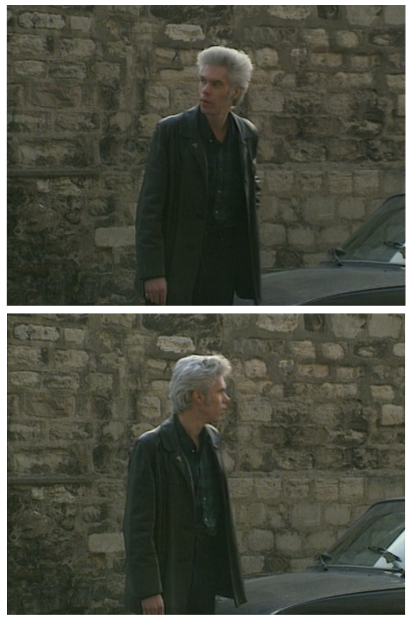 Jarmusch grew up in Ohio, became obsessed with movies in Paris and learned how to make them in New York City. According to his friend Waits, his hair went gray when he was 15, and “he always felt like an immigrant in the teenage world.” I suspect he’s never bothered to try to impress people before, so it all comes naturally. When I saw him in that interview it occurred to me how much people now would hate a young indie director popping up being that fucking cool. If you got a problem with the A24 directors, just imagine if they looked and sounded like Lee Marvin, but in a leather jacket and with white Elvis hair. I think today only musicians could get away with that.
Jarmusch grew up in Ohio, became obsessed with movies in Paris and learned how to make them in New York City. According to his friend Waits, his hair went gray when he was 15, and “he always felt like an immigrant in the teenage world.” I suspect he’s never bothered to try to impress people before, so it all comes naturally. When I saw him in that interview it occurred to me how much people now would hate a young indie director popping up being that fucking cool. If you got a problem with the A24 directors, just imagine if they looked and sounded like Lee Marvin, but in a leather jacket and with white Elvis hair. I think today only musicians could get away with that.
And I guess he is one. He and his producer Carter Logan have “an enthusiastically marginal rock band” called SQÜRL, and he’s always gravitated towards musicians. At this point he’d used Waits, John Lurie and Screamin’ Jay Hawkins as actors, and later he’d have collaborations with Neil Young, Iggy Pop, Sonic Youth and the RZA.
I genuinely treasure him as a one-of-a-kind filmmaker. He likes to make movies that are slow, quiet and uneventful, yet he never seems self-serious. They are stylish but never flashy. I can’t imagine him ever being tempted to be more commercial or follow what anyone else is doing, but he also doesn’t strike me as someone turning his nose up to pop culture. I just don’t think it’s very relevant to him. And that he doesn’t act like he’s saying anything makes what he is saying much more interesting to me.
I love NIGHT ON EARTH. It’s a movie that seems pretty timeless, and also seems like maybe it couldn’t have been made at any other time. It is the one-of-a-kind creation of a unique artist, bringing a style, tone and perspective to the screen unlike what anyone else wanted to or could do. It’s inexpensive compared to many other movies, but it represents a very talented international cast and some people with money (financiers JVC and distributors Fine Line Features*) helping give a little more reach to an interesting, uncompromised voice. I like when that happens. More people should do that.
*Fine Line Features is the “prestige” arm of New Line Cinema that also released THE PLAYER, and yes, JVC is the electronics company. According to their listing on IMDb, their first was Jarmusch’s own MYSTERY TRAIN – maybe the Japanese-speaking stars were a factor in getting them on board? Between that one and this one they produced GRAVEYARD SHIFT, PRAYER OF THE ROLLERBOYS and POINT BREAK. Shit, not bad! Or at least one of them is a classic and one is notable. They also had a hand in DR. GIGGLES and MALCOLM X. You know, stuff like that. For Jarmusch they also did DEAD MAN and my personal favorite GHOST DOG: WAY OF THE SAMURAI. They seem to have switched over to just anime and then stopped making moves in 2008.
trivia:
I didn’t catch this, but the manager who’s mad at the drunk rocker dudes that Corky drops off at the airport is played by Lisanne Falk, who co-starred with Ryder as Heather McNamara in HEATHERS.
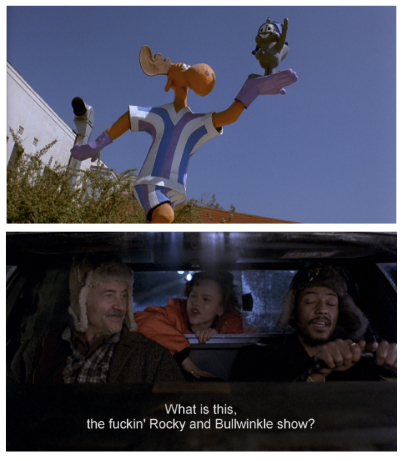 not trivial, but in fact very important:
not trivial, but in fact very important:
Since this is the summer of BORIS AND NATASHA: THE MOVIE mania, I want to note that I noticed two references to ol’ Moose and Squirrel in NIGHT ON EARTH: a roadside sculpture seen in the Los Angeles segment, and Rosie Perez as Angela making fun of YoYo and Helmut’s winter hats in the New York City one.


























May 25th, 2022 at 8:19 pm
I think I say this here every time Jarmusch comes up, but I always keep pushing his movies back on my watchlist, because they look pretty boring, but when I actually see them, I’m amazed by how entertaining they are. This is my favourite of his (out of those that I have seen). Sometimes all you need for a good time, is a bunch of people talking.